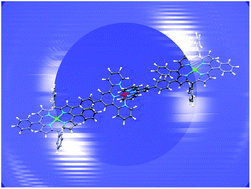Homoleptic complexes of a porphyrinatozinc(ii)-2,2′:6′,2′′-terpyridine ligand†
Abstract
Three homoleptic complexes containing the metalloligand 7-(4-([2,2′:6′,2′′-terpyridin]-4′-yl)phenyl)-5,10,15,20-tetraphenylporphyrinatozinc(II), 1, have been prepared. [Zn(1)2][PF6]2, [Fe(1)2][PF6]2 and [Ru(1)2][PF6]2 were characterized by 1H and 13C NMR spectroscopy and mass spectrometry, and the electrochemical and photophysical properties of the complexes have been investigated. In solution, each complex undergoes two reversible porphyrin-centred oxidation processes, with an additional reversible metal-centred oxidation for [Fe(1)2][PF6]2 and [Ru(1)2][PF6]2. Solution absorption spectra are dominated by the Soret and Q bands of the metalloligand 1. Spectroelectrochemical data for the complexes are presented. The results of a nanosecond transient absorption spectroscopic investigation of [Zn(1)2][PF6]2, [Fe(1)2][PF6]2 and [Ru(1)2][PF6]2 are presented. For [Zn(1)2][PF6]2, S1 excitation leads to an efficient intersystem-crossing to the T1 state, whilst for [Fe(1)2][PF6]2, excitation of the 1MLCT transition is followed by fast deactivation to the 3MC state followed by thermal decay to the ground state. Excitation of the 1MLCT transition of [Ru(1)2][PF6]2 results in an intersystem crossing to 3MLCT; triplet-to-triplet energy transfer occurs giving the [Zn(TPP)] T1 state which regenerates the ground state of the complex.



 Please wait while we load your content...
Please wait while we load your content...